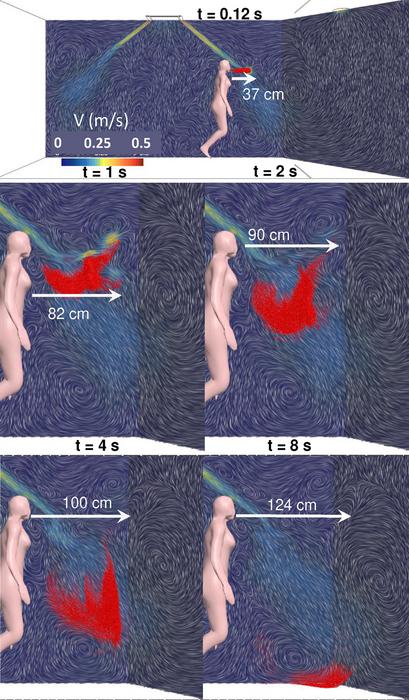WASHINGTON, Oct. 31, 2023 – When C-19 began to spread across the globe, its effects were significantly pronounced on cruise ships. Indeed, compared to other population segments, cruise ship passengers became disproportionately infected and often, ironically, stranded on board to quarantine. That’s why focus has been directed at addressing the need for improved ventilation on cruise ships since

Credit: Dimitris Drikakis
WASHINGTON, Oct. 31, 2023 – When C-19 began to spread across the globe, its effects were significantly pronounced on cruise ships. Indeed, compared to other population segments, cruise ship passengers became disproportionately infected and often, ironically, stranded on board to quarantine. That’s why focus has been directed at addressing the need for improved ventilation on cruise ships since
In Physics of Fluids, by AIP Publishing, a group of researchers from Cyprus examined how ventilation can affect transmission of airborne viruses in a typical cruise ship cabin based on guidelines developed before and after the pandemic.
“The most recent standards and regulations on room safety regarding the airborne transmission of viruses focus on high rates of air exchange,” said author Dimitris Drikakis. “But this can be inefficient in terms of energy consumption, can compromise passenger comfort as it generates strong air drafts, and most importantly, can spread saliva droplets up to five times more when passengers cough.”
Drikakis and his team conducted simulations for virus droplets from a cough in a typical cruiser cabin that accommodates two or more people, with different ventilation rates and different positions of the person emitting the cough. Computational fluid dynamics testing ranged from 1.5 to 15 air changes per hour (ACH) to capture all possible scenarios, from minimal ventilation to rates exceeding the most recent recommendations.
“The study reveals that a higher ventilation rate is not the best strategy to avoid spreading airborne diseases,” Drikakis said. “Complete evaporation of the saliva droplets may not necessarily mean all viruses or bacteria become instantly inactive. Therefore, we should aim at minimum droplet spreading inside the cabin and different ventilation strategies for occupied cabins.”
After analyzing the results, the team determined the ideal use of ventilation systems to operate at medium flow rates of around 3 ACH when a cabin is occupied, to increase to 15 ACH for at least 12 minutes after it has been vacated. In this way, the air would be completely refreshed for the next occupants. They also recommend the same minimum time of 12 minutes as a “clearance wait time” for similar-sized rooms with a minimum of 15 ACH.
“Our main argument for the proposed values is the necessity to minimize droplet spreading while maintaining good ventilation levels, comfort and energy consumption,” said Drikakis. “Keeping ventilation at the proposed values reduces energy consumption and improves passenger comfort in contrast to the use of higher ventilation rates.”
###
The article “Virus spreading in cruiser cabin” is authored by Konstantinos Ritos, Dimitris Drikakis, and Ioannis W. Kokkinakis. The article will appear in Physics of Fluids on Oct. 31, 2023 (DOI: 10.1063/5.0169992.) After that date, it can be accessed at http://aip.scitation.org/doi/full/10.1063/5.0169992.
ABOUT THE JOURNAL
Physics of Fluids is devoted to the publication of original theoretical, computational, and experimental contributions to the dynamics of gases, liquids, and complex fluids. See https://pubs.aip.org/aip/pof.
###
Journal
Physics of Fluids
DOI
10.1063/5.0169992
Article Title
Virus spreading in cruiser cabin
Article Publication Date
31-Oct-2023




